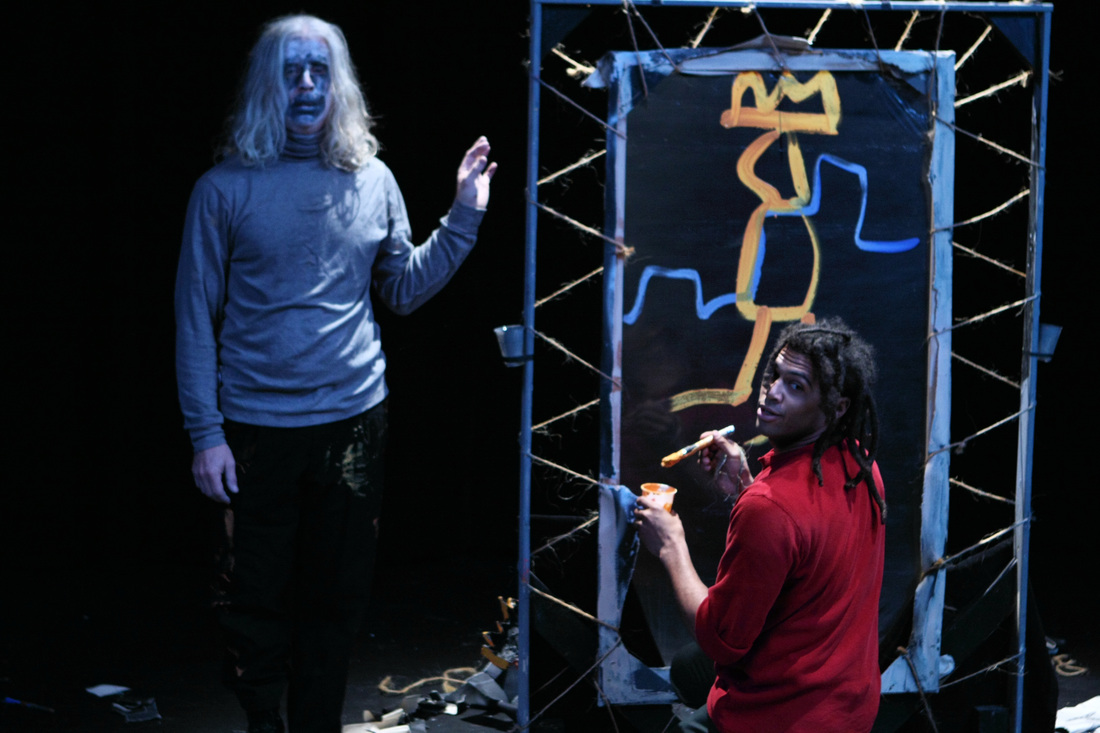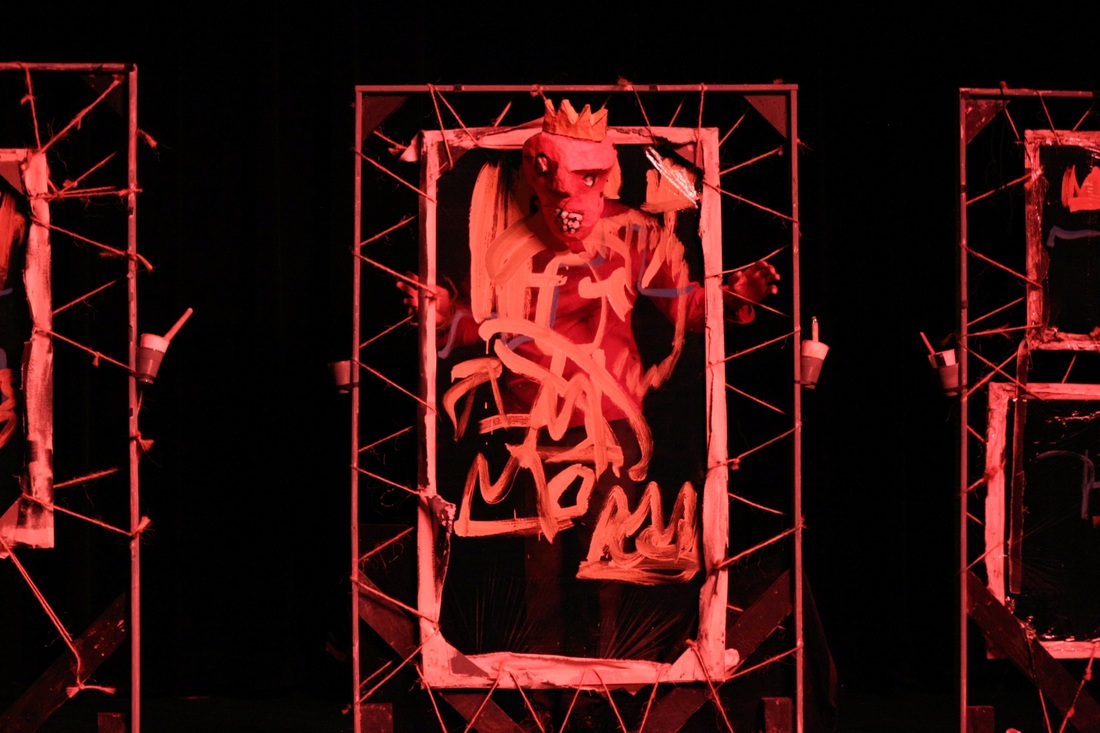Not the SAMO
Off-Leash Area's recent piece for their tiny garage stage, an homage to the life and art of Jean Michel Basquiat, is as witty, poignant, frenetic, impetuous and creative as the mercurial artist’s work itself.

The 1980s, by all accounts, were intoxicating in the world of visual art. After decades of cerebral work—rigorous and austere minimalism, cool and quixotic conceptualism, massive earthworks—things took a turn. Passion, painted surfaces, and personal expression began to thaw what had become a static market. Collectors in the U.S., Europe and Asia, like heat-seeking missiles armed with cash, homed in on hot new artists. Dealers upped their game, refining their marketing approaches to address collectors’ desires. And the art market, ever hungry for the new, began to boom.
Into this milieu stepped such artists as David Salle, Robert Longo, Julian Schnabel, Keith Haring… and Jean Michel Basquiat. A Brooklyn native, Basquiat’s Haitian father was an accountant and loved jazz; his Puerto Rican mother was an art lover and museum-goer who spoke three languages. After his parents’ marriage disintegrated and enduring his father’s beatings, the teenage Basquiat took to the streets.
To support himself he sold postcards he’d drawn, t-shirts he’d painted. Along with his friend, Al Diaz, Basquiat began tagging buildings in the neighborhood, dashing distinctive lines, shapes and iconography, as well as fragmented phrases and cryptic sayings on the walls. Their tag (or copyright, or “brand”) was SAMO (for Same Old Shit) — which is not what Off-Leash Area has created with the remount of its 2012 physical-theater work, S.A.M.O.—Like a Fiery Comet Jean Michel Basquiat Shoots Across the Sky.
Basquiat’s life was short (he died of a heroin overdose at 27) and, fittingly, S.A.M.O. is only an hour long. But packed into that 60 minutes, in Off-Leash’s tiny garage/performance space, is an encapsulation of Basquiat’s life that’s as witty, poignant, abstract, frenetic, kinetic, daring, questioning, confrontational, impetuous and creative as the artist’s work itself. S.A.M.O. feels like a Basquiat painting brought to vivid life.

Basquiat’s work ignited the art world with a 1981 show in which he deployed his evolving, graffiti-like style on bits of foam rubber and lumber he’d found, the imagery smeared and smooshed onto the media. He had a penchant for appropriation, which ranged widely from human anatomy to popular culture, comic-book heroes to Bible sayings, and his own prophet-like slogans plainly taking aim at both the art world and the comforts of white culture. Dealers saw an opportunity. And Basquiat was prolific — his output was huge, and it was a creative deluge fueled by drugs.
Dancer Brian Evans displays all of this, with frenetic intensity and resonant emotion, in his portrayal of Basquiat: the artist’s quick, sure slashes of line and shape; the inspiration to roll into the canvas, with his body, large splotches of paint; the craving for his next fix; the intelligence that drove his decisive and incisive commentary; the pressure to continue putting out the same stuff to feed a frenzied art market’s insatiable demand for his work.
Meanwhile, always hovering, cajoling, prodding, consoling or needing are Paul Herwig’s anomalous, ever-morphing cast of characters: Death, Basquiat’s girlfriend ( Suzanne Malouk), Andy Warhol (with whom Basquiat became close), a critic, a collector, jailor, executioner. Together, Herwig and Evans conjure a life that couldn’t sustain itself, but which impacted our notions of artistry, commodity, fame, race and memory forever.
The props for S.A.M.O. are simple and devastatingly effective. Pieces of blackboard on a rope loop are chalked with Herwig’s character. Rope also functions alternately as bars of a cell and, as Evans wraps a skein tightly around his arm, a junkie’s fix kit. Herwig slices through white paper lining the walls with a box cutter, seemingly murdering a pristine sensibility even before Evans begins to move among the multiple easels, painting vigorously on sheets of clear plastic wrap.
Just as skeletons and skulls became prominent imagery in Basquiat’s work, so are they in S.A.M.O. As is the cartoonish crown that came to symbolize the artists’ singular iconography, the image with which Herwig anoints Evans using a hand gesture. Herwig gradually surrounds Evans with the crowned and skeletal representations of Basquiat’s beloved heroes: Burroughs, Hendrix, Coltrane, Joplin. And finally—as he was never short on self-regard, despite the relentless psychological pressure and pain in which he found himself immersed—Basquiat himself becomes canvas, artwork, commodity.
Myth and mythologizer. Genius and junkie. Prescient and ever present. Mercurial and a hothouse flower pressured to produce. Off-Leash, and Herwig and Evans, capture it all with transformative performances that, at the same time, reverberate with current politics and events. Originally created as a short included in one of Off-Leash Area’s garage tours, here S.A.M.O. was extended and reformatted into this astonishing one-hour performance. It deserves an even larger stage—and audience.
Noted performance information:
S.A.M.O.—Like a Fiery Comet Jean Michel Basquiat Shoots Across the Sky, a collaboration of Paul Herwig and dancer Brian Evans, was presented by Off-Leash Area in six performances from January 23 through February 1, 2015.
Camille LeFevre is a long-time dance writer in the Twin Cities and the editor of The Line, an online publication about the creative economy of the Twin Cities.